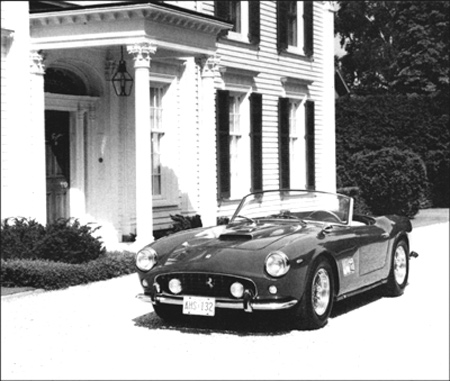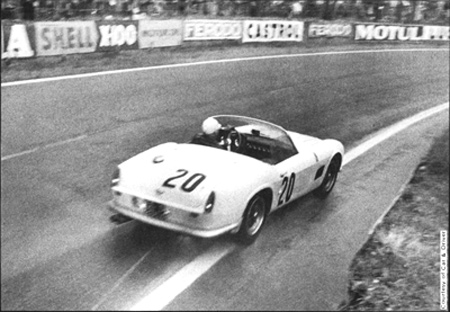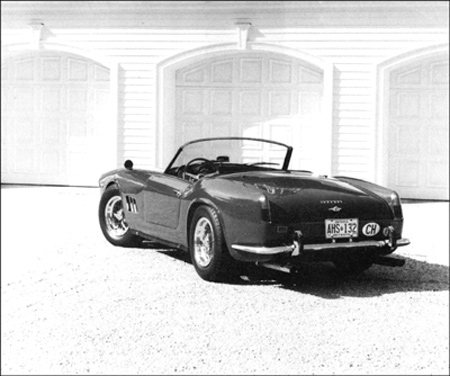
|
February 6th 2008
By George, Still a Good Book!
Price: $39.95 USD 122 pages, 124 illustrations, size 8.25 x 11 inches.
ISBN: 1-58850-061-6 Ordered from:
VelocePress.com
Dick Merritt, in the introduction to this now classic book, spins a tale about how George Carrick, then living in Canada, beat Merritt to the purchase of a Ferrari California. Originally for sale at $2500, the car was missing the windshield. �While I was trying to make up my mind if thea was a bargain or not, a letter arrived reporting that the price had suddenly jumped to around $4000�, wrote Merritt. �My gut reaction was that it would never sell for that ridiculous figure. However, a Canadian chap, (Carrick), who didn�t know any better, bought the car, and after much travail, had a windshield fitted by Scaglietti in Modena.�

A stunning
SWB California, photographed by Clive Clark.
|
In light of the recent sale at Gooding Auctions of a 250GT Spyder California for 3.3 million, Merritt�s story and Carrick�s wisdom seems unbelievable. But Carrick�s determination bears testament to the fact that the Spyder California is a classic now in the stratosphere of prices, and a pretty good return on investment for those who kept the car long enough.
Obviously, even back in those super deal years of the early 1970s, Carrick knew that the Spyder California was and ultra unique model in a range of ultra unique cars, the queen of production Ferraris. As an homage to the California, Carrick wrote �A Ferrari of Particular Distinction� doing such a credible job of research that it stands to this day as a valuable reference guide. First published in 1976 by John W. Barnes of Cavallino, it was resurrected by Stephen Glenn in 2000 for his new electronic publishing company, VelocePress. It was a scanned book, but reasonably priced and go the book back in circulation. (Disclaimer: the author of this review co-founded VelocePress with Stephen Glenn).
By 2007, VelocePress was now owned by Dave and Lynn Getz at LMG Auto, and they in turn gave the Carrick book a facelift, reformatted to portrait (vertical) size, added forty six pages and improved the scanned images throughout the book. Additions include the factory worksheet of five of the Spyder California --those hard to find documents which provide all the build specifications. All are obvious and worthwhile upgrades and at the price ($39.95 plus shipping), adding the updated version to the library is wise decision.
So, what do you get for your dollar? Carrick provides a historical perspective, explaining the development of the 3 liter engine, which �subsequently met with considerable success in the 250GTO, 250L/M, and 250P model cars.� The Spyders were �fitted with a progressively modified and improved version of this motor.� Nothing new here now but the text is unchanged since 1976. In the next section, however, Carrick detailed the racing successes of the California, which were marginal since the car was a street car and not set up for racing. But in 1959, a California driven by the team of Ginther/Hively won the GT class at Sebring and placed 9th overall. A few months later at LeMans, Grossman and Tavano took one to 5th overall in the 24 hour event. Grossman drove another Spyder to a nice list of wins in SCCAs B and C production classes in 1959 and 1960, and Carrick lists them all, adding a number of somewhat rare photos of this beautiful car in action.

Chassis 2015 GT at LeMans in 1960, driven by Sturgis/Schlesser.
|
In another section pre-production developments are detailed, starring with the 375 America convertible built for King Leopold, and picking up design motifs from the special bodied PF 250GTs ordered for Peter Collins and tracing them to the Californias.
Unlike the PF 250GT convertibles, the Californias were constructed by Scaglietti, the first of which (0769GT) was almost identical to the 250GT Tdf, (it also looked like a TdF without a top) and delivered to American George Arents in January of 1958. The last, a SWB, was completed on February 6, 1963, chassis 4137GT. Between the two 100 cars were built with a variety of engines, modifications, interiors, and body details.
Like Ferrari, Carrick�s heart was in the engine, and his chapter on the California power plant was probably the first to religiously document the differences between the 128C, the 128D, 128F and 168 type engines. A description is followed by tables which give the differences between each of the engine types which were offered on the Californias.
Carrick does just about the same with California chassis specs, first describing the differences then follows up in much more detail with a chart comparing a number of cars, both in long wheelbase and short wheelbase forms. Beauty, as they say, is in the details and here is beauty.
Just as the engines and chassis are documented, so are the various body details and the interiors, which were surprisingly stark for a street car. Many of these differences are via illustration, and each photo in that section are accompanied by chassis numbers. We then get to see some rare photos of the California with a factory hardtop--with at least two styles available. By the time you get to this section of the book, you�ll know about as much as you�ll ever need to know about the Spyder California and surely a great guide to buying one, if you can cough up the 3 mil it takes to buy one today.

Rear view of the SWB open headlight California, as photographed by Clive Clark.
|
It�s a classic text, virtually unchanged since it�s original publication. That is not a bad thing, however as the text was definitive then as it is now. Plus, it reminds us of those times when Ferraris were affordable and driven. Further on in the 1976 introduction, Merritt, still thinking about Carrick�s $4000 deal, wrote �Today, a California the equal of George�s could cost me upwards of $20,000, if I could find an owner willing to part with his prized possession.�
|

|



